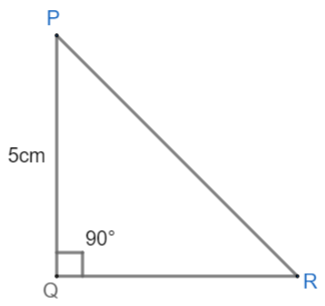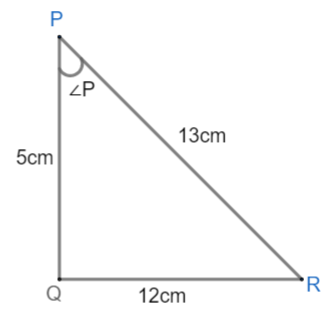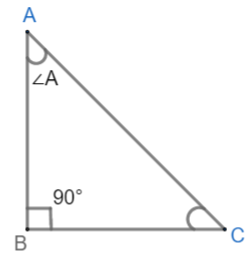
In the triangle $\Delta PQR$ right angled at Q, PR+RQ = 25cm and PQ = 5cm. Determine the value of sin P, cos P and tan p
Answer
574.2k+ views
Hint: First we will assume the first variable from PR and QR as x then we can easily calculate other in terms of other. Then, we will use Pythagora's theorem to calculate all sides stated as, "In a right angled triangle the square of hypotenuse sides is equal to sum of squares of other two sides". Then, we will use the given formula to calculate the result.
\[\sin \theta =\dfrac{\text{Perpendicular}}{\text{Hypotenuse}},\cos \theta =\dfrac{\text{Base}}{\text{Hypotenuse}},\tan \theta =\dfrac{\text{Perpendicular}}{\text{Base}}\]
Complete step-by-step answer:
Let us first understand the scenario by drawing a figure of $\Delta PQR$ right angled at Q.

Given that PR + QR = 25 cm.
Let the length of side PR be x, then by substituting this value in above equation we get:
\[\begin{align}
& x+QR=25 \\
& QR=25-x \\
\end{align}\]
Now, we have three sides of $\Delta PQR$ as PQ = 5, PR = x and QR = 25-x.
Now, because $\Delta PQR$ is a right angled triangle, we can use Pythagora's theorem to find the rest two sides. It is stated as,
"In a right angled triangle the square of hypotenuse sides is equal to sum of squares of other two sides"
Here we have hypotenuse as side PR and right angled at Q. Using Pythagoras theorem in $\Delta PQR$ we get:
\[{{\left( PR \right)}^{2}}={{\left( PQ \right)}^{2}}+{{\left( QR \right)}^{2}}\]
Substituting the value of PR = x, QR = 25-x and PQ = 5 in above we get:
\[{{\left( x \right)}^{2}}={{\left( 5 \right)}^{2}}+{{\left( 25-x \right)}^{2}}\]
Now, using the identity ${{\left( a-b \right)}^{2}}={{a}^{2}}-2ab+{{b}^{2}}$ in ${{\left( 25-x \right)}^{2}}$ we get:
\[{{x}^{2}}={{5}^{2}}+{{\left( 25 \right)}^{2}}+{{x}^{2}}-50x\]
Cancelling ${{x}^{2}}$ from both sides, we get:
\[\begin{align}
& 0={{5}^{2}}+{{25}^{2}}-50x \\
& 625+25=50x \\
& 650=50x \\
& 5x=65 \\
& x=\dfrac{65}{5}=13 \\
\end{align}\]
Hence, length of side PR = 13 cm.
Now the length of QR = 25-x = 25-13 = 12 cm.
Hence, we have obtained in $\Delta PQR$
PQ = 5, PR = 13 and QR = 12.

Finally, we will consider sin P, cos P and tan P.
If ABC is a right angled triangle, right angled at B then for $\angle A$

\[\begin{align}
& \sin A=\dfrac{\text{Perpendicular}}{\text{Hypotenuse}}=\dfrac{BC}{AC} \\
& \cos A=\dfrac{\text{Base}}{\text{Hypotenuse}}=\dfrac{AB}{AC} \\
& \tan A=\dfrac{\text{Perpendicular}}{\text{Base}}=\dfrac{BC}{AB} \\
\end{align}\]
Using these formula in $\Delta PQR$ we have:
\[\begin{align}
& \sin P=\dfrac{\text{QR}}{\text{PR}}=\dfrac{12}{13} \\
& \cos P=\dfrac{\text{PQ}}{\text{PR}}=\dfrac{5}{13} \\
& \tan P=\dfrac{\text{QR}}{\text{PQ}}=\dfrac{12}{5} \\
\end{align}\]
Therefore, value of $\sin P=\dfrac{12}{13},\cos P=\dfrac{5}{13}\text{ and }\tan P=\dfrac{12}{5}$ is the required answer.
Note: Another method to calculate the value of tan P is by using the trigonometric formula:
\[\dfrac{\sin \theta }{\cos \theta }=\tan \theta \]
We can substitute Q = P and use this formula to calculate tan P.
Values of $\sin P=\dfrac{12}{13}\text{ and }\cos P=\dfrac{5}{13}\text{ }$ then \[\tan P=\dfrac{\sin P}{\cos P}=\dfrac{\dfrac{12}{13}}{\dfrac{5}{13}}\]
Cancelling 13 both sides, we get:
$\tan P=\dfrac{12}{5}$ Value of tan P is anyway the same.
\[\sin \theta =\dfrac{\text{Perpendicular}}{\text{Hypotenuse}},\cos \theta =\dfrac{\text{Base}}{\text{Hypotenuse}},\tan \theta =\dfrac{\text{Perpendicular}}{\text{Base}}\]
Complete step-by-step answer:
Let us first understand the scenario by drawing a figure of $\Delta PQR$ right angled at Q.

Given that PR + QR = 25 cm.
Let the length of side PR be x, then by substituting this value in above equation we get:
\[\begin{align}
& x+QR=25 \\
& QR=25-x \\
\end{align}\]
Now, we have three sides of $\Delta PQR$ as PQ = 5, PR = x and QR = 25-x.
Now, because $\Delta PQR$ is a right angled triangle, we can use Pythagora's theorem to find the rest two sides. It is stated as,
"In a right angled triangle the square of hypotenuse sides is equal to sum of squares of other two sides"
Here we have hypotenuse as side PR and right angled at Q. Using Pythagoras theorem in $\Delta PQR$ we get:
\[{{\left( PR \right)}^{2}}={{\left( PQ \right)}^{2}}+{{\left( QR \right)}^{2}}\]
Substituting the value of PR = x, QR = 25-x and PQ = 5 in above we get:
\[{{\left( x \right)}^{2}}={{\left( 5 \right)}^{2}}+{{\left( 25-x \right)}^{2}}\]
Now, using the identity ${{\left( a-b \right)}^{2}}={{a}^{2}}-2ab+{{b}^{2}}$ in ${{\left( 25-x \right)}^{2}}$ we get:
\[{{x}^{2}}={{5}^{2}}+{{\left( 25 \right)}^{2}}+{{x}^{2}}-50x\]
Cancelling ${{x}^{2}}$ from both sides, we get:
\[\begin{align}
& 0={{5}^{2}}+{{25}^{2}}-50x \\
& 625+25=50x \\
& 650=50x \\
& 5x=65 \\
& x=\dfrac{65}{5}=13 \\
\end{align}\]
Hence, length of side PR = 13 cm.
Now the length of QR = 25-x = 25-13 = 12 cm.
Hence, we have obtained in $\Delta PQR$
PQ = 5, PR = 13 and QR = 12.

Finally, we will consider sin P, cos P and tan P.
If ABC is a right angled triangle, right angled at B then for $\angle A$

\[\begin{align}
& \sin A=\dfrac{\text{Perpendicular}}{\text{Hypotenuse}}=\dfrac{BC}{AC} \\
& \cos A=\dfrac{\text{Base}}{\text{Hypotenuse}}=\dfrac{AB}{AC} \\
& \tan A=\dfrac{\text{Perpendicular}}{\text{Base}}=\dfrac{BC}{AB} \\
\end{align}\]
Using these formula in $\Delta PQR$ we have:
\[\begin{align}
& \sin P=\dfrac{\text{QR}}{\text{PR}}=\dfrac{12}{13} \\
& \cos P=\dfrac{\text{PQ}}{\text{PR}}=\dfrac{5}{13} \\
& \tan P=\dfrac{\text{QR}}{\text{PQ}}=\dfrac{12}{5} \\
\end{align}\]
Therefore, value of $\sin P=\dfrac{12}{13},\cos P=\dfrac{5}{13}\text{ and }\tan P=\dfrac{12}{5}$ is the required answer.
Note: Another method to calculate the value of tan P is by using the trigonometric formula:
\[\dfrac{\sin \theta }{\cos \theta }=\tan \theta \]
We can substitute Q = P and use this formula to calculate tan P.
Values of $\sin P=\dfrac{12}{13}\text{ and }\cos P=\dfrac{5}{13}\text{ }$ then \[\tan P=\dfrac{\sin P}{\cos P}=\dfrac{\dfrac{12}{13}}{\dfrac{5}{13}}\]
Cancelling 13 both sides, we get:
$\tan P=\dfrac{12}{5}$ Value of tan P is anyway the same.
Recently Updated Pages
Master Class 10 General Knowledge: Engaging Questions & Answers for Success

Master Class 10 Science: Engaging Questions & Answers for Success

Master Class 10 Social Science: Engaging Questions & Answers for Success

Master Class 10 Maths: Engaging Questions & Answers for Success

Master Class 10 English: Engaging Questions & Answers for Success

Master Class 10 Computer Science: Engaging Questions & Answers for Success

Trending doubts
Why is there a time difference of about 5 hours between class 10 social science CBSE

Write a letter to the principal requesting him to grant class 10 english CBSE

What is the median of the first 10 natural numbers class 10 maths CBSE

The Equation xxx + 2 is Satisfied when x is Equal to Class 10 Maths

Which of the following does not have a fundamental class 10 physics CBSE

State and prove converse of BPT Basic Proportionality class 10 maths CBSE




